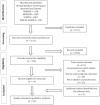Protein Intake from Birth to 2 Years and Obesity Outcomes in Later Childhood and Adolescence: A Systematic Review of Prospective Cohort Studies
- PMID: 33903896
- PMCID: PMC8483959
- DOI: 10.1093/advances/nmab034
Protein Intake from Birth to 2 Years and Obesity Outcomes in Later Childhood and Adolescence: A Systematic Review of Prospective Cohort Studies
Abstract
Emerging evidence shows an association between protein intake during infancy and later obesity risk, and that association may differ by protein sources. This systematic review summarized and evaluated prospective cohort studies assessing the long-term association of total protein intake and protein sources during infancy (from birth to 2 y) with subsequent obesity outcomes in childhood or adolescence. Literature searches were conducted in Embase, Medline, Scopus, and Web of Science. Sixteen studies that reported associations between total protein intake and/or protein intake from different sources from birth to 2 y and ≥1 obesity outcomes in childhood or adolescence from 9 cohorts were identified. Most studies (11/16) were rated as high quality. The most frequently reported association was total protein intake and BMI (up to 10 y) with 6 out of 7 cohorts showing significant positive associations. Similar associations were found for animal protein, but not for plant protein. Limited studies examined the association between protein intake (both total and sources) and body composition (body fat, fat mass, and fat-free mass) and revealed inconsistent findings. Overall, higher intakes of total and animal protein during infancy were associated with higher BMI in childhood and adolescence. Future studies investigating the contribution of protein sources in long-term obesity development are needed. This review was registered at PROSPERO as CRD42020166540.
Keywords: childhood; infancy; obesity; protein intake; protein sources.
© The Author(s) 2021. Published by Oxford University Press on behalf of the American Society for Nutrition.
Figures


References
-
- World Health Organization . Obesity and overweight. [Internet]2020. [cited 10 Sep 2020]. Available from: https://www.who.int/news-room/fact-sheets/detail/obesity-and-overweight.
-
- Lu L, Xun P, Wan Y, He K, Cai W. Long-term association between dairy consumption and risk of childhood obesity: a systematic review and meta-analysis of prospective cohort studies. Eur J Clin Nutr. 2016;70(4):414–23. - PubMed
-
- Brands B, Demmelmair H, Koletzko B; EarlyNutrition Project.. How growth due to infant nutrition influences obesity and later disease risk. Acta Paediatr. 2014;103(6):578–85. - PubMed
-
- Lucas A. Programming by early nutrition: an experimental approach. J Nutr. 1998;128(2):401S–6S. - PubMed
Publication types
MeSH terms
LinkOut - more resources
Full Text Sources
Other Literature Sources
Medical

